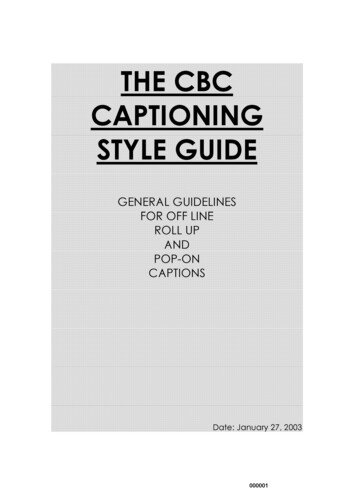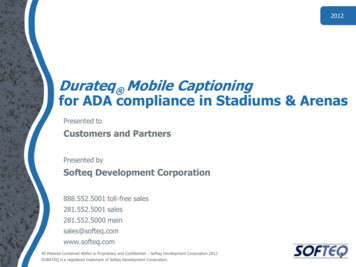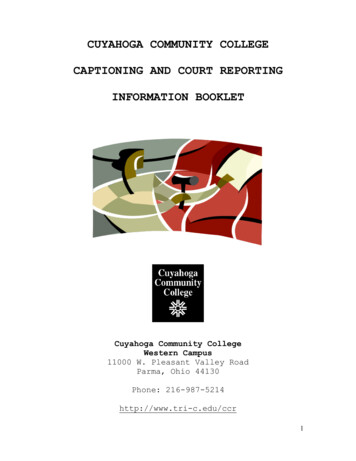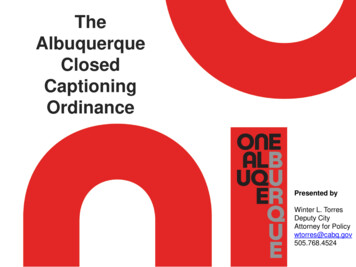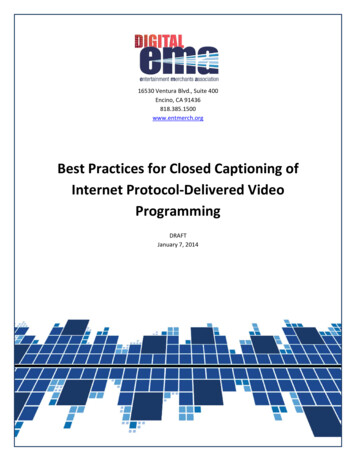
Transcription
16530 Ventura Blvd., Suite 400Encino, CA 91436818.385.1500www.entmerch.orgBest Practices for Closed Captioning ofInternet Protocol‐Delivered VideoProgrammingDRAFTJanuary 7, 2014
EMA BEST PRACTICES FORCLOSED CAPTIONING OF INTERNET PROTOCOL‐DELIVERED VIDEO PROGRAMMINGThe Closed Captions Working Group of EMA’s Digital Supply Chain Committee developed theattached Best Practices for Closed Captioning of Internet Protocol‐Delivered VideoProgramming. The EMA Closed Captions Working Group was created to develop a betterunderstanding of, and appropriate best practices for compliance with, the legal requirementsimposed by federal law and regulation for closed captioning of Internet Protocol‐deliveredvideo programming and to identify other best practices for the conversion of television closedcaption files for transmission over the Internet.Why is the Best Practices document needed? The Twenty‐First Century Communications and Video Accessibility Act of 2010 andaccompanying regulations promulgated by the Federal Communications Commissionrequire that all full‐length video delivered via the internet be able to be viewed withclosed captions if the video airs on broadcast or cable television with closed captions onor after the applicable effective date. A number of different protocols are being used for the delivering closed caption filesaccompanying broadcast video, which creates inefficiencies. Conversion of closed captions accompanying broadcast video and subsequent editingcan be challenging. Greater consistency in how closed captions for internet protocol delivered videoprogramming will better serve diverse consumer constituencies.Closed Captions Working GroupThe Best Practices document was developed over a series of meetings amongretailers/distributors to address their needs to fulfill delivery to the consumer and meet legalrequirements.Participants in the Closed Captions Working Group were:Amazon – Andy Bruncke, Steve Geiger, Joe PaveyBest Buy – Brigit LeeGoogle – Ken Harrenstien, Steve Maher
Microsoft Corp. – Michelle Burbridge, Dennis Cronin, Laura SmithMovieLabs – Craig Seidel, , Pierre‐Anthony Lemieux (Sandflow)Netflix – Dae KimRovi Corporation – David Hazlett, James MooreVudu – Aaron Martin, Adam SimpsonEMA Staff – Sean Bersell, Jennifer Lane Burnell, Mark Fisher(Names and employers of Working Group Participants are for information only and do notsignify endorsement.)
EMA’s Best Practices for Closed Captioning of InternetProtocol‐Delivered Video Programming in the United States*DRAFT – December 11, 2013The EMA Closed Captions Working Group was created to develop a better understanding of,and appropriate best practices for compliance with, the legal requirements imposed by federallaw and regulation for closed captioning of Internet Protocol‐delivered video programming andto identify other best practices for the conversion of television closed caption files fortransmission over the Internet.Certification If Captions Are Not ProvidedThe Twenty‐First Century Communications and Video Accessibility Act of 2010 andaccompanying regulations promulgated by the Federal Communications Commission requirethat all full‐length video delivered via the internet be able to be viewed with closed captions ifthe video airs on broadcast or cable television with closed captions on or after the applicableeffective date. There are various effective dates for the requirement, which are dependent onwhether the video programming is pre‐recorded and whether it has been edited for theInternet: September 30, 2012, for all prerecorded programming that is not edited for Internetdistribution;March 30, 2013, for all live and “near‐live” programming [programming that isperformed and recorded within 24 hours prior to its initial airing on television];September 30, 2013, for all prerecorded programming that is edited for Internetdistribution.*This document is a working draft and is subject to revision. Participation in the working group should not beconsidered endorsement of all of the draft recommendations.No effort is being made by EMA or the EMA Digital Council to in any way obligate any market participant to adhereto the Best Practices for Closed Captioning of Internet Protocol‐Delivered Video Programming. Whether to utilizethe Best Practices for Closed Captioning of Internet Protocol‐Delivered Video Programming in whole or in part isleft entirely to the individual discretion of individual market participants, using their own independent businessjudgment. Moreover, EMA and the EMA Digital Council disclaim any warranty or representation as to thesuitability of the Best Practices for Closed Captioning of Internet Protocol‐Delivered Video Programming for anypurpose, and any liability for any damages or other harm you may incur as a result of utilizing them.1
There are special rules for video programming that is already in the library of the videoprogramming provider/distributor before it is shown on television with closed captions. Startingin March 2014, those videos must be captioned within 45 days of being shown on televisionwith captions. The window is reduced to 30 days in 2015 and 15 days in 2016.The regulations do not cover user‐generated content (unless that content is included in thevideo programming as broadcast on television).The content licensor (“video programming owner”) is to provide the closed captioning file tothe online video service (“video programming distributor” or “video programming provider”).The content licensor and the online video service are to establish a mechanism for ongoingcommunication whether a particular video is covered by the closed captioning requirement,and the online video service must make a “good faith effort” to identify covered programmingusing that mechanism. An online video service is entitled to rely on a certification from thecontent provider that a particular video is not subject to the closed captioning requirement.Recommended Best Practice for Certification if Captions Are Not Included (Manual Delivery):If a closed caption file is not provided for intended IP‐delivered video programming, the videoprogramming owner should provide the following certification:[Partner name] certifies that captions are not required for this video upload because:This content has never aired on television in the U.S.This content has only aired on television in the U.S. without captions.This content has not aired on U.S. television with captions since September 30, 2012This content does not consist of full‐length video programming.This content does not fall within a category of online programming that currentlyrequires captions under FCC regulations (49 C.F.R. § 79.4(b)).The FCC and/or U.S. Congress has granted an exemption from captioningrequirements for this content.Recommended Best Practice for Certification if Captions Are Not Included (Electronic Delivery):If a closed caption file is not provided for intended IP‐delivered video programming, the videoprogramming owner should provide the above certification in both the avails and the metadatafor that programming. The Media Entertainment Core Metadata (MEC) and EMA ContentAvailability Metadata (EMA Avails) provide the means to transfer the certification and reasonselectronically.2
Recommended Captioning FormatsIn order for a broadcast video to be delivered over the Internet with closed captions, the closedcaption file must be converted from the CEA‐608‐E [CEA 608] protocol used for televisionclosed captions to a format suitable for Internet delivery (of which there are several), afterwhich the captions can be edited to display properly. This conversion and editing can be donemanually (extremely difficult and time‐consuming), from scratch (very expensive), or by usingsoftware to extract and reformat the captioning data (preferred).Even with closed captioning software, conversion can be challenging, especially when itinvolves a broadcast closed caption file in a legacy format.The intent of these recommendations is to facilitate the distribution of closed captions in amanner that completely preserves their original presentation, or at least provides a functionallyequivalent presentation. Most, if not all, captions in the United States are authored within theCEA‐608 specification. It is, therefore, important to have recommendations that efficiently andaccurately deliver captions sourced from CEA‐608.It is possible, however, to have captions that exceed CEA‐608 capabilities, such as CEA‐708‐Ddigital television captions. Consequently, recommendations are included that support captionswith capabilities beyond CEA‐608. (Although the advanced caption recommendations cansupport CEA‐608, we anticipate the CEA‐608 recommendations will be preferred for conveyingCEA‐608 captions.)There are two applicable standards for delivering CEA‐608 captions. The first is Scenarist ClosedCaption (SCC), a de facto standard for the conveyance of CEA‐608 data. The second is SMPTE‐TT, which was standardized by the Society of Motion Picture and Television Engineering(SMPTE), and is a profile of the Timed Text Markup Language (TTML), previously referred to asDFXP. SMPTE‐TT also opens the door for advanced captions and subtitles, beyond CEA‐608.There are many ways to ensure compliance with the statutory and regulatory requirements tofaithfully present closed captions, and users of CEA‐608 captions are encouraged to understandthe “safe harbor” provisions associated with compliant SMPTE‐TT in the FCC regulationsimplementing the Twenty‐First Century Communications and Video Accessibility Act of 2010 [47C.F.R. 79.4(c)(1)(i)].Recommended Best Practice for CEA‐608 Caption Delivery:The following three options are recommended.Option 1: Delivery of CEA‐608 closed caption files in SCC formatClosed captions are delivered using SCC files. SCC offers a simple means to transfer CEA‐608equivalent data. CEA‐608 caption data is tied by frames as a byproduct of which frames include3
the data. SCC substitutes timecodes for frame synchronization, but otherwise uses CEA dataexactly.These files shall use the .scc extension.Option 2: Delivery of CEA‐608 closed caption files in SMPTE‐TT formatCEA‐608 data is conveyed using SMPTE‐TT as constrained by one of the following profiles:Profile 1:To maximize interoperability, it is recommended that SMPTE‐TT files should conform to CFF‐TT Text Profile (see [CFF‐TT]) with, optionally,the additional constraints of SDP‐US applied (see [SDP]); and if the caption source is CEA‐608, SMPTE RP 2052‐10 should be used to convert CEA‐608 to SMPTE‐TT. In particular, the CEA‐608 data should be tunneled according toSection 5.10, allowing it to be preserved in the SMPTE‐TT document; and if the caption source is CEA‐708, SMPTE RP 2052‐11 should be used to convert CEA‐708 to SMPTE‐TT. In particular, the CEA‐708 data should be tunneled according toSection 5.13, allowing it to be preserved in the SMPTE‐TT document.NOTE: CFF‐TT does not preclude the use of tunneling transport as specified in Section 5.4 ofSMPTE ST 2052‐1.Profile 2:1. Structural Constraintsa. A document MUST contain a tt element.b. A document MUST contain both a head and body element.c. A document MUST contain a ttp:profile attribute on the tt element wherethe value of the attribute is [?].2. Parameter Constraintsa. A document MUST NOT contain a ttp:markerMode attribute.3. Styling Constraintsa. A document MUST NOT contain a length expression that uses the pxunit of measure unless (1) the length expression appears in a tts:extentattribute on the tt element, or (2) a tts:extent attribute appears on the ttelement.b. A document MUST NOT contain a length expression that uses the c(cell) unit of measure unless a ttp:cellResolution attribute appears on thett element.4
c. A document MUST NOT contain a length expression that uses the emunit of measure.d. A document MUST NOT contain a tts:overflow attribute.4. Layout Constraintsa. A document MUST NOT contain a region such that the computed valuesof the origin and extent properties of the region would result in itextending outside the root container region.b. A document MUST NOT contain two regions such that the spatial extentof the two regions would (visually) overlap.c. A document MUST NOT contain content such that more than four regionswould be selected into a given synchronic intermediate document.5. SMPTE Extension Constraintsa. A document MUST NOT contain a smpte:image element.b. A document MUST NOT contain a smpte:backgroundImage attribute.c. A document MUST NOT contain a smpte:backgroundImageHorizontalattribute.d. A document MUST NOT contain a smpte:backgroundImageVerticalattribute.6. Encoding Constraintsa. Content Authors MUST adhere to the following constraints:i. A document MUST be concretely represented as a well‐formed[XML10] entity.ii. A document MUST be concretely represented using the UTF‐8character encoding [UNICODE].The use of features defined in SMPTE‐TT is permitted unless explicitly precluded, and the use ofother profiles that implement the features of this profile are acceptable. Video programmingdistributors that have additional or alternative preferences should clearly communicate thosepreferences.The files shall use the .xml extension.Option 3: CEA‐708 Caption Delivery:Captions are conveyed using the CEA‐708 tunneling methods described in CEA‐708.Recommendations Regarding Other Timed Text Methods:Also acceptable is Simple Delivery Profile (SDP), which is in process with the W3C TT WorkingGroup. Other formats are not recommended.5
Frame RatesClosed caption data files are separate from the video data files. Ideally, the caption frame rateshould match the native frame rate of the source. However, they often do not, andsynchronization of the two can be a problem.Television in North America is generally broadcast at a standard rate of 29.97 frames persecond (FPS). Internet video delivery, however, can support a variety of frame rate formats, anda number of distributors of IP‐delivered video programming require films and TV shows to be ata frame rate of 23.976 or 25 FPS.These varying frame rate requirements mean that the closed caption files that were created forNorth American broadcast will not match the Internet video frame rate. As a result, the framerate of the caption file must be reconfigured to the frame rate utilized by the Internet videocontent distributor (such as 23.976 FPS), and if necessary, the time code must be stretched orshrunk.This can be a challenge for a number of reasons. In many cases, the caption file has SMPTE‐based timestamps and fails to specify the frame rate. In such cases, one has to guess the framerate until the correct frame rate is identified. In other cases, the video has been transcoded to aslightly different frame rate, or the captions were generated using a differently transcoded oredited version of the video.To address this issue, some Internet video content distributors require the content provider toprovide a closed caption data file that is already synchronized to the video data file. Othershave developed processes to fix the caption files in‐house.Recommended Best Practice:If the Internet video content distributor does not require the closed caption data file to bealready synchronized to the video data file, the closed caption data file may be submitted in anyframe rate in which it was created, so long as the frame rate is clearly indicated in the file name,metadata, or code. However, for .SCC files, the file name should indicate whether the file isdrop‐frame (DF) or non‐drop‐frame (NDF) and the timecode should behours:minutes:seconds:frames for non‐dropframe timebase and hours:minutes:seconds;framesfor dropframe timebase.6
References[CEA-608][CEA-708][CFF-TT]CEA-608-E, “Line 21 Data Services”, April 1, 2008CEA-708-D, “Digital Television (DTV) Closed Captioning”, August 1, 2008Digital Entertainment Content Ecosystem (DECE). Common File Format &Media Formats CFFMediaFormat-1.1r1.pdf[EMA-Avails][MEC][SCC]EMA Avails Metadata, [add reference]Media Entertainment Core Metadata, http://www.movielabs.com/md/mec/Scenarist Closed Caption Format,http://www.theneitherworld.com/mcpoodle/SCC TOOLS/DOCS/SCC FORMAT.HTML [editors note: Although there is no de jure standard, this seemsto be the best reference for SCC.]Simple Delivery Profile, http://www.w3.org/TR/ttml10-sdp-us/SMPTE ST2052-1:2010, “Timed Text Format (SMPTE-TT)”SMPTE RP2052-10:2012, “Conversion from CEA-608 Data to SMPTE-TT”SMPTE RP2052-11, “Conversion from CEA-708 Data to SMPTE-TT”W3C Timed Text Markup Language (TTML) 1.0 (Second E-TT][SMPTE-608][SMPTE-708][TTML]7
16530 Ventura Blvd., Suite 400 Encino, CA 91436 818.385.1500 www.entmerch.org Best Practices for Closed Captioning of Internet Protocol‐Delivered Video Programming
